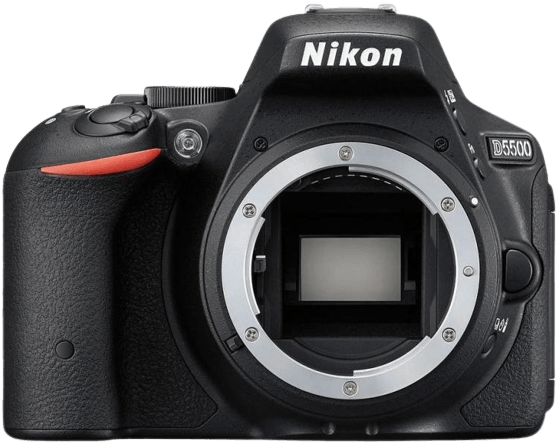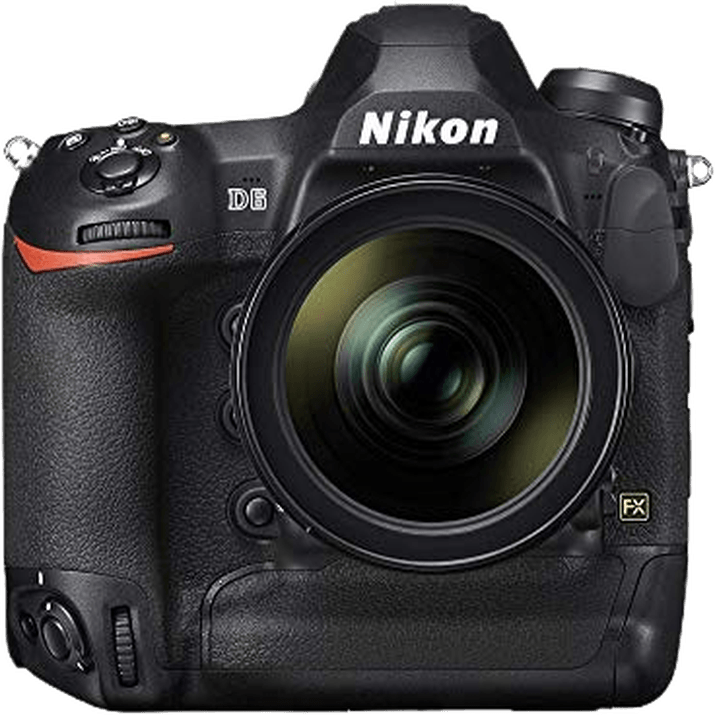Nikon D5500 vs D6 Comparison
Nikon D5500

Nikon D6

The Nikon D6 outperforms the Nikon D5500 with a 19-point lead, scoring 80/100 compared to the D5500’s 61/100. Both cameras are DSLRs, with the D5500 released in 2015 and the D6 in 2020. They share similar features, but the D6 excels in certain aspects, justifying its higher score.
The D6 surpasses the D5500 in performance and capabilities, making it a more professional option. However, the D5500 has its advantages, such as its compact size (124 x 97 x 70mm) and lighter weight (420g), compared to the D6’s larger dimensions (160 x 163 x 92mm) and heavier weight (1450g). This makes the D5500 more portable and easier to handle.
Despite the D5500’s portability, the D6 is the clear winner in overall performance. Although it comes with a higher launch price of $6500 compared to the D5500’s $900, the D6’s robust features and superior performance make it worth the investment for professionals.
Nikon D5500 vs D6 Overview and Optics
The Nikon D6 outperforms the Nikon D5500 in optics with a score of 75/100, compared to the D5500’s 65/100. Both cameras share certain specifications, such as the CMOS sensor type, Nikon F lens mount, and lack of image stabilization. However, the D6 surpasses the D5500 in key areas, contributing to its higher score.
The Nikon D6 has a superior processor, the Expeed 6, compared to the D5500’s Expeed 4. This contributes to the D6’s faster shooting speed of 14 frames per second, compared to the D5500’s 5 frames per second. Additionally, the D6 has a full-frame sensor, which is larger than the D5500’s APS-C sensor. This results in better image quality, as evidenced by the D6’s DXOMARK sensor score of 97, compared to the D5500’s 84.
On the other hand, the Nikon D5500 has a higher megapixel count at 24.2, compared to the D6’s 20.8. This provides the D5500 with slightly more detailed images, but it is not enough to outweigh the advantages of the D6’s other superior specifications.
The Nikon D6’s faster processor, shooting speed, and larger sensor size contribute to its higher score in optics. These features make it a better choice for those seeking top-notch image quality and performance. While the Nikon D5500 has a higher megapixel count, it falls short in other crucial areas, making the D6 the clear winner in this comparison.
Nikon D5500 vs D6 Video Performance
The Nikon D6 outperforms the Nikon D5500 in video capabilities, scoring 83 out of 100 compared to the D5500’s score of 70. Both cameras share some common specifications, such as a maximum video frame rate of 60fps and built-in time-lapse functionality. However, there are significant differences that contribute to the D6’s higher score and superior performance.
One of the main advantages of the Nikon D6 is its 4K video resolution, providing a maximum video dimension of 3840 x 2160. This allows for higher quality and more detailed video recordings compared to the Nikon D5500, which only offers Full HD video resolution with a maximum video dimension of 1920 x 1080. The D6’s 4K resolution offers a significant improvement in video quality, making it a better choice for those seeking professional-level video capabilities.
While the Nikon D5500 does not match the D6’s video performance, it still provides solid video capabilities with its Full HD resolution. For casual users and those who do not require 4K resolution, the D5500 remains a reliable option for capturing high-quality video. The shared feature of 60fps frame rate and time-lapse functionality in both cameras ensures that users can achieve smooth motion and creative time-lapse videos regardless of their choice.
In comparing the video capabilities of the Nikon D5500 and Nikon D6, it is clear that the D6 is the superior choice for those seeking professional-level video quality and performance, thanks to its 4K resolution. However, the D5500 still offers satisfactory video capabilities for casual users and those who do not require the highest video resolution. Ultimately, the decision between the two cameras will depend on the individual’s video needs and preferences.
Nikon D5500 vs D6 Features and Benefits
The Nikon D6 outperforms the Nikon D5500 with a feature score of 87/100, compared to the D5500’s 59/100. Both cameras share several specifications, such as a 3.2-inch touchscreen, flip screen, and WiFi connectivity. However, the D6 surpasses the D5500 in several areas, ultimately contributing to its higher score.
The D6 has a superior screen resolution of 2,359,000 dots, significantly higher than the D5500’s 1,037,000 dots. This difference enables the D6 to provide a clearer and more detailed image preview and review. In addition, the D6 includes GPS and Bluetooth capabilities, which the D5500 lacks. GPS allows users to geotag their photos, while Bluetooth facilitates easier file transfer and remote control functionality.
The D5500, on the other hand, does not have any significant advantages over the D6 in terms of features. The D5500’s lower feature score reflects its limitations compared to the more advanced D6.
Considering these points, the Nikon D6 is the superior camera in terms of features. Its higher screen resolution, GPS, and Bluetooth capabilities make it a more versatile and powerful option for photographers. The D5500, while still a reliable camera, falls short in comparison to the D6. Thus, photographers seeking advanced features and better overall performance should opt for the Nikon D6.
Nikon D5500 vs D6 Storage and Battery
The Nikon D6 outperforms the Nikon D5500 in storage and battery, scoring a perfect 100 points compared to the D5500’s 35 points. Both cameras accept different memory cards; the D5500 uses SD/SDHC/SDXC cards, while the D6 is compatible with CFexpress and XQD cards.
The Nikon D6 excels with two memory card slots, allowing for more storage and backup options. It also boasts an impressive battery life of 3,580 shots, powered by the EN-EL18c battery. Additionally, the D6 supports USB charging, offering extra convenience for users.
On the other hand, the Nikon D5500 has only one memory card slot and offers a significantly lower battery life of 820 shots, using the EN-EL14 battery. It does not support USB charging.
Based on these specifications, the Nikon D6 clearly offers superior storage and battery capabilities compared to the Nikon D5500. This makes the D6 the better choice for photographers who need more storage flexibility and longer battery life, while the D5500 may suffice for casual users with less demanding needs.
Nikon D5500 vs D6 – Our Verdict
Are you still undecided about which camera is right for you? Have a look at these popular comparisons that feature the Nikon D5500 or the Nikon D6:

